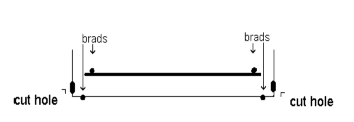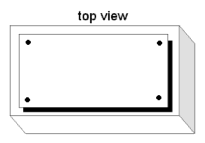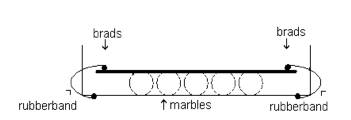BACKGROUND:
Earthquakes hardly ever occur one at a time.
Foreshocks or smaller earthquakes which occur before the "mainshock."
An "aftershock" is any earthquake that occurs after the main
earthquake. The shaking people feel during an earthquake is caused by the
energy released when movement is caused by a rupture in the Earth's crust or
uppermost mantle. If you compare an earthquake to snapping your fingers, the
rupture is the fingers snapping, but what you hear, or "feel" is
the sound waves travelling through the atmosphere. The larger the energy
released the larger the earthquake. Then energy moves in what we refer to as
"seismic waves." Seismic waves are considered a physical wave and
requires that it travels through a substance. It can be moved in many ways,
but the major ways are primary (push-pull and P) waves and secondary (shear
or S) waves
A wave travels through a material when a force pushes
on that material and the material resists being pushed. For example, when
you speak, your voice compresses a volume of air. One of the properties of
air (and just about any other material) is that it resists being compressed
into a smaller volume. When your voice compresses this volume of air, its
resistance pushes back against neighboring volumes of air. These volumes
then resist compression, and they push back against their neighbors,
generating a wave of compression that travels through all the volumes of air
between your mouth and the person hearing you.
Seismic waves can cause weak, moderate, or strong
earthquakes.
PROCEDURE:
- Prior to lab construct primary shaker tables. Make
enough units so that the students can work in groups of 2 or 3. Here are
directions:
 
Materials:
8 long stemmed brads or nails
4 strong, thick rubber bands
marbles
cardboard box with lid
string
plastic container lid
Directions:
-
Cut a section from the cardboard box
lid so that it will fit inside of the cardboard box as shown in the
picture below.

-
Take 4 brads and insert them from the
inside of the cardboard box so that the stems fall outside of the box.
Insert the remaining four brads into the cut lid of the box. Make sure
that the brads are not directly on the edge as this will cause the lid
to tear when it is pulled.

-
Fasten the rubber bands to the brads
inside of the cardboard box. Fasten the other ends of the rubber bands
to the brads on the cut lid. Leave the lid inside of the box.
-
Place several marbles in a container
top. Put the marbles in their container under the cardboard lid in the
box, to allow it to move freely when up or down.
-
Make a small hole in one end of the
box. Attach a piece of string to one end of the lid and. insert the
opposite end of the string through the hole in the box. This move the
lid. Don't forget to tie a knot at the end of the string where comes out
of the box, this will prevent it from going back inside. Your
"primary shaker table" is complete.
-
Discuss with the class that the Earth
shakes during an earthquake. Explain that shaking is caused when stress
builds up on the outer portion of the Earth and it "relieves"
itself.
-
Discuss the words weak, moderate, and
strong, by giving examples of familiar objects to the students. Weak
refers to an earthquake that does not cause much shaking; Moderate might
be when a house shakes and things might fall from shelves. Strong is when
a house shakes a lot, causing many things to fall.
-
Divide the students into groups of 2 or
3. Give each group a primary shaker table. Familiarize the students with a
creating strong, moderate, and weak earthquakes. A strong quake occurs
when the students pull the string all the way out; a weak one occurs when
they barely pull the string a little way out; and a moderate is between a
strong and a weak. Make them repeat these a few times before going on to
step 5.
-
Direct the students to build a house or
town on the shaker table. Use toys that have been donated or that you have
asked the children to bring from home. Do not let the students make their
structures too big or the weight may prevent moving the shaker table.
Instruct students to observe what happens in a weak, moderate, or strong
earthquake. Make sure you explain that the students are to build the same
house or town three times and observe what each type of "shake"
does to the same structure. After they experiment, have them describe what
happened.
-
This exercise helps the students to
understand that the Earth shakes during an earthquake, and that even
houses which are "anchored" to the Earth still experience the
Earth's shaking. Moreover, buildings may experience structural failure
during a particular earthquake, but not during others. This is because
each earthquake has its own "signature" or specific
characteristics.
-
Make sure that you do not over
emphasize the damage that can occur during an earthquake; you do not want
the students to become fearful. This would be a good time to discuss your
school's policy during an earthquake or other disasters. If your school
does not have a plan, you may wish to contact local government agencies.
-
Discuss with students what they should
do when an earthquake occurs.
They should try and remain calm. Panic does not help a situation.
Make a judgement of whether to stay where put or move. Many people are
injured as they enter or leave buildings, but in other situations, safety
is just a few steps away. The intensity of shaking and a sense of the
magnitude of damage should be assessed before moving. Teach your students
that each earthquake may be different, and knowledge of different
responses is necessary.
If you hear glass breaking, turn your head away from the glass.
If outside, stay away from buildings and power lines.
If inside take cover under a heavy table or desk.
It is important to remember to use critical thinking skills during a
disaster, whether an earthquake, volcano or weather hazard, there are
certain steps one should take. In a big disaster, you have to make do with
what you have available. Humans seem to get enormous strength during
disasters; they tend to bond together. Disasters make people realize how
insignificant lives are, when nature decides to unleash her powers. But
after any crisis it is always good to say that we did all that we could
before it happen. Preparedness is a skill used not only in disasters, but
in every day little crisis.
|